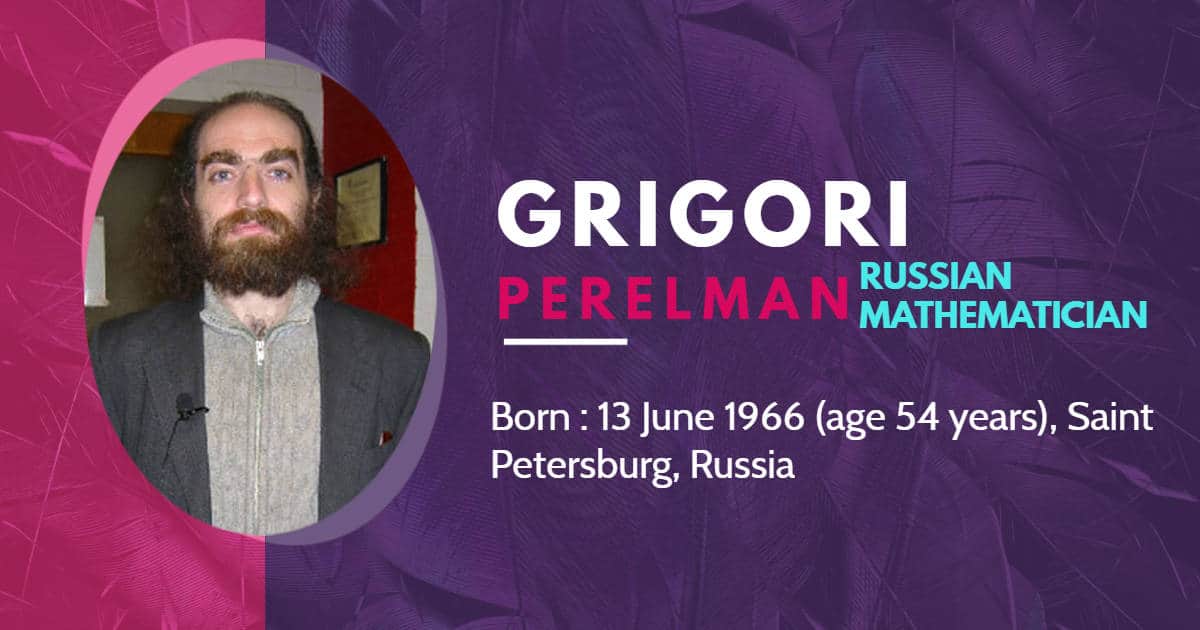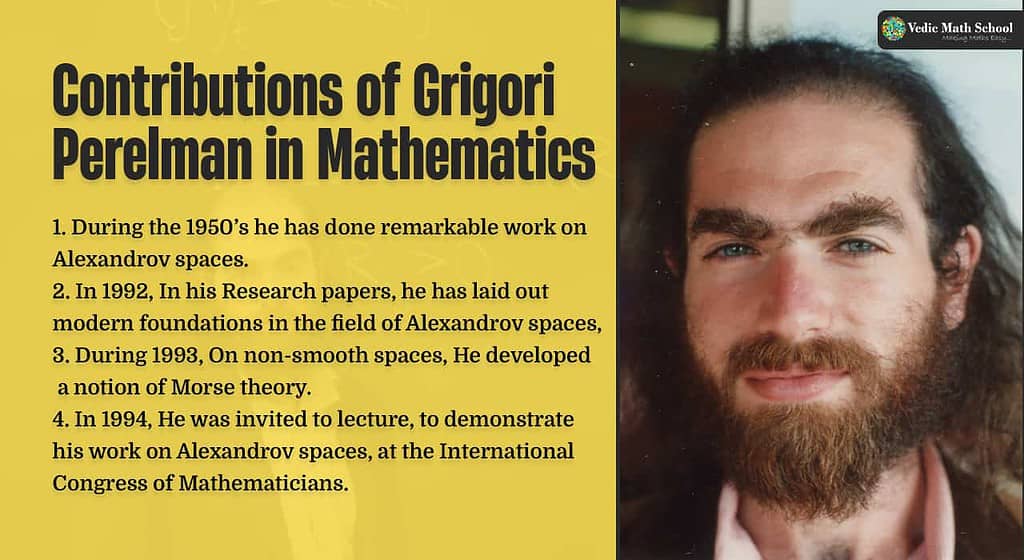Grigori Yakovlevich Perelman is a Russian mathematician who was born on 13 June 1966 in Leningrad, the Soviet Union to Russian-Jewish parents. He made great contributions to geometric topology and Riemannian geometry.
Her mother, Lyubov was a mathematic graduate, but she gave up to raise him.
He was a bright student. From the age of 10, he started showing his mathematical skill to the world. His mother, after-school mathematics training program, enrolled him in Sergei Rukshin. At the Leningrad Secondary School, he continued his mathematical education. This is a specialized school where advanced physics and mathematics are been taught. Grigori outshined in all subjects excluding physical education.

Grigori Yakovlevich Perelman life Milestones:
- In 1982, he won a gold medal while competing in the International Mathematical Olympiad as a member of the Soviet Union team. He was competing with international high school students.
- In the late 1980s and early 1990s, with a powerful endorsement from the geometer Mikhail Gromov, He got research positions at numerous universities in the United States.
- In the 1990s, he made prominent contributions to the subject of Alexandrov spaces.
- After his PhD in 1990, He began to work at the USSR Academy of Sciences at the Leningrad Department of Steklov Institute of Mathematics.
- In 1991, for his work on Aleksandrov’s spaces of curvature, At the St. Petersburg Mathematical Society, he got the Young Mathematician Prize.
- In 1992, he was invited as a mathematics guest lectures in Stony Brook University and New York University. This is where he started working on Ricci curvature.
- In 1993, At the University of California, Berkeley, he received Miller Research Fellowship for two-years.
- In 1994, he proved the soul conjecture in Riemannian geometry.
- In 1994, he got many job offers from top universities like Stanford and Princeton, but he rejected them all.
- In 1995, To continue his research work, He returned to the Steklov Institute in Saint Petersburg.
- In November 2002, He gave the first of three preprints to the arXiv.
- In 2002 and 2003, he developed new techniques in the analysis of Ricci flow, and presented a detailed picture of a proof of Thurston’s geometrization conjecture,
- In August 2006, for Perelman’s revolutionary insights into the geometric structure and the analytical and of the Ricci flow and his contributions to geometry, he was offered the Fields Medal.
- On 22 December 2006, the Scientific Journal Science appreciated Perelman’s proof of the Poincaré conjecture as the scientific “Breakthrough of the Year”.
- This is the first such recognition in the field of mathematics.
- On 18 March 2010, It is said that he was about to get the first Clay Millennium Prize for solving the Poincaré conjecture.
Must Read These Also.
- Sir Andrew John Wiles KBE FRS is an English mathematician and a Royal Society Research Professor
- George Boole was a largely self-taught English mathematician, philosopher, and logician
Grigori Perelman Books and Research Papers
Here are the list of few of the books written by Grigori
- A. D. Aleksandrov spaces with curvatures bounded below.
- Collapsing with No Proper Extremal Subsets.
- Construction of manifolds of positive Ricci curvature with big volume and large Betti numbers.
- Elements of Morse theory on Aleksandrov spaces.
- Extremal subsets in Alexandrov spaces and the generalized Liberman theorem.
- Proof of the soul conjecture of Cheeger and Gromoll.
Contributions of Perelman Grigori in Mathematics
Here are few of Grigori Perelman contribution:
- During the 1950’s he has done remarkable work on Alexandrov spaces.
- In 1992, In his Research papers, he has laid out modern foundations in the field of Alexandrov spaces,
- During 1993, On non-smooth spaces, He developed a notion of Morse theory.
- In 1994, He was invited to lecture, to demonstrate his work on Alexandrov spaces, at the International Congress of Mathematicians.

Interesting facts about Perelman Grigori
Few of the Interesting facts about Grigori:
- He didn’t like receiving awards and rewards for his mathematical research works.
- Grigori rejected the prize of one million dollars.
- He solved and gave solutions for many open mathematical problems for years.
Must Read These Also.
- Muḥammad ibn Mūsā al-Khwārizmī, or al-Khwarizmi and formerly Latinized as Algorithmi
- René Descartes was a French philosopher, mathematician, and scientist who invented analytical geometry
Awards and Rewards under the name of Grigori Perelman
Awards Grigori was nominated for:
- European Mathematical Society Prize
- Fields Medal
- Millennium Prize
- Saint Petersburg Mathematical Society Prize
To Honor him an asteroid named 50033 Perelman was named after him.
Quotes By Grigori Perelman
“I’m not interested in money or fame; I don’t want to be on display like an animal in a zoo.”
FAQ About Perelman
Where is Grigori Perelman now?
Grigori Perelman resides in St. Petersburg, Russia
Who was the first mathematician ever to decline the Fields Medal?
Grigori Perelman was the first mathematician who has declined the field medals. He declined it by saying that he doesn’t care about the rewards or money. He values knowledge.
What did Perelman Grigori do?
Perelman Grigori worked on the following Mathematical topics:

- Riemannian geometry
- Proof of the soul conjecture
- Geometric topology
- Proof of the Poincaré conjecture
Why did Grigori Perelman decline the medal?
Grigori Perelman didn’t want to get highlighted. He said, “I’m not interested in money or fame; I don’t want to be on display like an animal in a zoo.”
How old is Grigori Perelman?
He is 54 years old. He was born in 1966.
Who solved one of the Millennium Problems?
Grigori Perelman Solved Millennium Problems. He even solved many problems that were not been solved for years.





Typo of a the year just above (Grigori Perelman):
“Contributions of Grigori Perelman in Mathematics
“Here are few of Grigori Perelman contribution:
“During the 1950’s he has done remarkable work on Alexandrov spaces. ”
Probably 1950’s should be 1970’s. Thanks. -Bruce